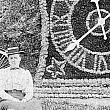Influences on the Design of John Ball Park
by Rebecca Smith Hoffman
John Ball Park is an early example of the public urban “country park.” As a “country park” it was designed to “evoke the visitor’s memory of rural scenes and his instinctive attraction to nature with its pastoral, softly meandering tree-formed space.” Central Park in New York City, designed by Frederick Law Olmsted in 1857 was carried out as a ‘country park.’
Development of the urban public park in the Midwest United States began in 1864 with the creation of Lake (now Lincoln) Park in Chicago. However, the true impetus for Midwestern urban park design came in 1869 with the passage of the Illinois Park Commission Act and the creation of the Chicago West and South Park Commissions, which retained Olmsted and his associate Calvert Vaux as designers. In that same year, John Ball wrote his will leaving forty acres to the city of Grand Rapids “for a Public Park, or other public uses only.”
Olmsted’s design principles for an urban “country park,” as interpreted through the City Beautiful movement, were implemented by John Ball Park designer Eugene Goebel beginning in 1910, one year after he collaborated with Brunner and Carrère on the 1909 city plan. The Goebel design and the concept of the urban “country park” were the dominant influence on John Ball Park design for the next fifty years and remain the defining characteristics of the park as it exists today.
Another influence on Midwestern park design during this period also came from Chicago – the Prairie School of landscape design, which may be said to have begun with the appointment of Grand Rapids native Ossian Simonds as Superintendent of Graceland Cemetery in Chicago in 1881. Simonds was, along with Jens Jensen of Chicago, the father of the Prairie Landscape Design movement. An 1878 graduate of the University of Michigan, he founded its School of Landscape Design. While following Olmsted design principles and the theory of the country park, Simonds and Jensen emphasized the use of the Midwestern (particularly the prairie) landscape as a design theme, using native Midwestern plant species. Jensen especially emphasized low horizontal plantings, such as hawthorns and crabapples, to enhance the prairie effect.
A third major influence on park design was the American Playground movement, which reached the height of its influence with the creation of the Playground Association of America in 1906. Playground theory emphasized the importance of parks and active recreation for the physical and mental health of lower income citizens, especially children. Since the urban “country park” movement emphasized the restorative benefits of urban parks, country parks such as John Ball made a neat fit with playground theory in that play spaces could be inserted in the fields, meadows, glades and groves called for by Olmsted design principles, without seriously impairing the design intent. Charles Garfield of Grand Rapids was a national leader in the playground movement and the Association held its tenth annual meeting in Grand Rapids in 1916, attended by 1200 playground leaders from across the nation.
The urban country park went into decline with the rise of the automobile after World War II. Norman Newton, in his authoritative Design on the Land: The Development of Landscape Architecture (1971) described the new urban country park as a rarity. Newton lamented the loss. “There are those who assert that the ‘country park,’ with its pastoral, softly meandering tree-formed space, is no longer needed within the city in view of the relative nearness of countryside in this motor age. This is undoubtedly one reason for diminished popular demand, considering numerical terming at least. Psychologically, however, under the tensions, pressures, and incessant clamor of the hectic urban condition, there is even greater need today for the quick relief of the quiet, contemplative atmosphere of the quasi-rural ‘country park.’ And to assume glibly that the countryside is ‘near at hand for everybody’ – a statement frequently heard – is a cruel exaggeration; it will continue to be so until public transportation to the open country is freely or at least reasonably available to the lowest-income urban population.”

 facebook
facebook


